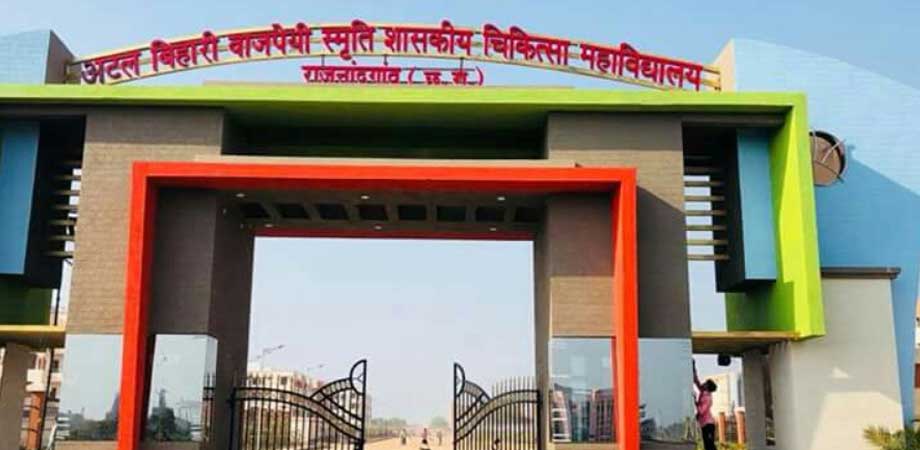"Setting Up More Medical Colleges", Says PM Modi: A FactCheck
 The medical college in Rajnandgaon, Chhattisgarh set up as part of Phase I of the ‘Establishment of new Medical Colleges attached with existing district/referral hospitals’ scheme.[/caption]
The medical college in Rajnandgaon, Chhattisgarh set up as part of Phase I of the ‘Establishment of new Medical Colleges attached with existing district/referral hospitals’ scheme.[/caption]
Prime Minister Narendra Modi on Monday delivered the keynote address at Grand Challenges Annual Meeting 2020, a gathering of policymakers and scientific leaders working on public health. While speaking to the delegates, PM Modi highlighted the government’s record of setting up medical colleges in rural areas and its impact on rural healthcare.
Claim: “We are setting up more medical colleges especially in rural areas. This ensures more opportunities for the youth. It brings better healthcare to our villages” - PM Modi
Fact: Partly True
According to Lok Sabha responses from the Ministry of Health and Family Welfare (MOHFW), the current government has floated a scheme called ‘Establishment of new Medical Colleges attached with existing district/referral hospitals’ which is being implemented by state governments.
Under this, 157 medical colleges have been approved in three phases, including 40 in ‘aspirational districts’ (those that have poor socio-economic indicators). This will lead to the generation of 15,700 seats, compared to the 27,180 MBBS seats that were available in 2015. As of September 18, 2020, 43 out of the 58 medical colleges in Phase 1 are operational. None of projects in Phase 2 and 3 have been completed yet.
These medical colleges primarily are targeted at under-served areas with at least 200-bed district hospitals. Preference will be given to district hospitals with higher number of beds and aspirational districts. The scheme is being centrally sponsored with a fund sharing ratio of 90:10 for the North East and Special Category States and 60:40 for the rest.
Out of the Rs 7,541 crores the Centre has allocated for the Phase 1 projects, Rs 7,507.70 crores have been released. For Phase 2, Rs 2,296.59 crores out of Rs 3,675 crores have been released. One fifth of the funds for Phase 3 has been released i.e Rs 3,121.81 crores out of Rs 15,499.7.
Govt takes the lead
The medical college boom started at the turn of the millennium, driven mostly by the private sector. From 2014, there was an especially steep increase in government medical colleges. That year, there were 189 medical colleges in the government sector out of the 404 colleges in total. By 2019, there were 539 medical colleges in the country, 279 of them being run by the state. State-run medical states had accounted for nearly two-thirds of the growth.
But the penetration of medical schools in rural districts was still lagging, which the new scheme has attempted to correct.
A 2014 study mapped 65 “priority districts” for the setting up of medical colleges based on factors like distance to the nearest one, rural population and the proportion of people with low standard of living index. They were primarily in Rajasthan, Madhya Pradesh, Uttar Pradesh, Chhattisgarh, Jharkhand, Bihar and Odisha.
According to the information released by MOHFW, Madhya Pradesh, Rajasthan and Uttar Pradesh are getting the lion’s share of the new colleges with 15, 23 and 27 respectively. In these states, almost one-third of the rural districts i.e those with rural population over 70%, didn’t have a medical college, according to another 2018 paper.
The paper also says, out of the 480 rural districts in India, only 132 (27.5%) had a medical college. Jharkhand, Jammu and Kashmir and Arunachal Pradesh had no medical colleges in rural districts. The attempt to rectify this anomaly has begun under the new scheme with the states getting 5, 7 and 1 medical colleges respectively.
In Uttar Pradesh, which had less than 10 state-run medical colleges before 2000, there are now at least 50 colleges, both government and private, waiting to get registered with the UP State Medical Council, says Secretary And Registrar, Rakesh Jain. “These are coming up in distant and neglected areas giving those living here better access to treatment of serious illnesses.”
The spate of deaths due to Japanese Encephalitis in Gorakhpur three years ago, pushed the government to provide better medical care in the surrounding districts like Basti and Azamgarh, he says. Soon after, government medical colleges were approved in these places and some are already operational.
Behind the numbers
While the pace in the setting up of medical colleges has certainly shot up since 2014, the impact may not be proportionate. In the context of providing auxiliary infrastructure, these colleges fare poorly. “There is a critical lack of teaching staff as trained educators don’t want to move here”, says Dr Balbir Singh Deswal from the Department of Community Medicine, SGT Medical College, Gurgaon.
It’s for the same reason that they tend to end up attracting less meritorious students, and not necessarily even local ones. “Even after they are trained, these doctors don’t prefer to fill up the thousands of vacant post in rural primary healthcare centres,” says Deswal.
“Healthcare is complex and doesn’t just depend on the number of doctors we produce. This is a myth that is being perpetuated”, says Dr R Balasubramanium, a development scholar who has worked extensively with remote tribes in Karnataka. Saying medical care isn't healthcare, he adds that it is more likely that the 1,50,000 Health and Wellness Centres coming up across the country, when properly administered, will have more of an impact on rural healthcare.


